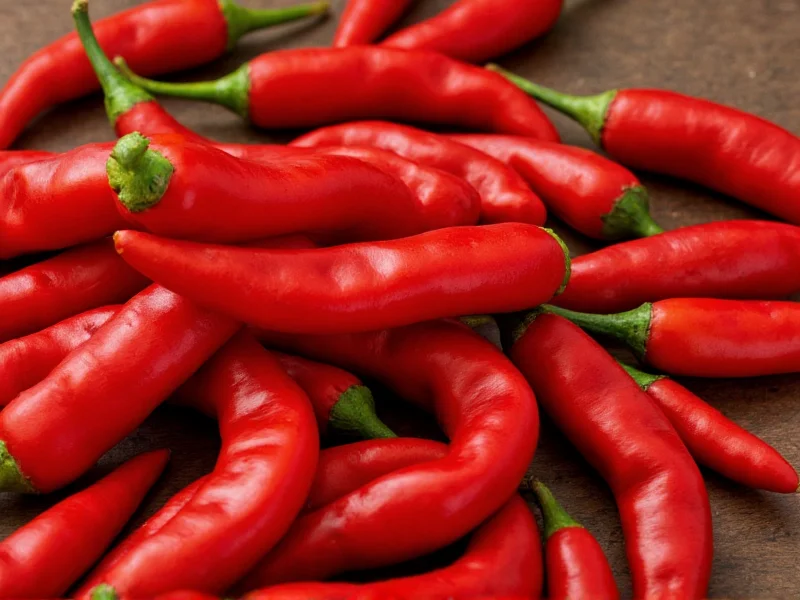Cayenne pepper's distinctive heat has made it a staple in kitchens and medicine cabinets worldwide. Understanding its precise heat level helps cooks and consumers use it effectively while avoiding unpleasant surprises. The Scoville scale, developed by pharmacist Wilbur Scoville in 1912, remains the standard measurement for chili pepper heat, quantifying the concentration of capsaicinoids—the compounds responsible for that burning sensation.
Understanding Cayenne Pepper's Heat Measurement
The heat of cayenne pepper isn't fixed but exists within a range due to various factors including growing conditions, variety, and maturity. Most commercially available cayenne peppers register between 30,000-50,000 SHU, though some specialty varieties can reach up to 100,000 SHU. This measurement represents how much sugar-water dilution would be needed to eliminate the heat sensation.
When comparing cayenne pepper heat to other common peppers, the differences become strikingly clear. A bell pepper registers zero SHU, while a typical jalapeño ranges from 2,500-8,000 SHU. This means cayenne pepper can be up to 20 times hotter than a jalapeño. Understanding these relative heat levels helps in recipe substitution and heat management.
| Pepper Variety | Scoville Heat Units (SHU) | Relative Heat Comparison |
|---|---|---|
| Bell Pepper | 0 SHU | 0x (No heat) |
| Jalapeño | 2,500-8,000 SHU | 1x (Baseline) |
| Cayenne Pepper | 30,000-50,000 SHU | 6-20x hotter than jalapeño |
| Habanero | 100,000-350,000 SHU | 20-70x hotter than jalapeño |
| Ghost Pepper | 855,000-1,041,427 SHU | 170-400x hotter than jalapeño |
Factors Influencing Cayenne Pepper Heat Levels
Several elements affect the final heat measurement of cayenne peppers. Climate plays a significant role—peppers grown in hotter, drier conditions typically develop higher capsaicin concentrations as a natural defense mechanism. Soil composition, particularly nitrogen levels, also impacts heat production. Counterintuitively, stressed plants often produce hotter peppers as the capsaicin serves as a protective compound.
The specific variety of cayenne matters considerably. While most fall within the standard range, some cultivars like the 'Thai Cayenne' can reach the upper limits of 50,000 SHU or beyond. Harvest timing affects heat levels too—peppers allowed to fully ripen to their characteristic red color generally develop more capsaicin than those picked earlier.
Practical Applications of Cayenne Pepper Heat
Understanding cayenne pepper's heat profile enables better culinary applications. When substituting cayenne for other spices, remember that 1 teaspoon of cayenne equals approximately 3 teaspoons of paprika in heat intensity. For those sensitive to spice, removing the white pith and seeds—where capsaicin concentrates—can reduce heat by up to 80% without sacrificing flavor.
Cooking methods significantly alter perceived heat. Adding cayenne early in the cooking process allows heat to mellow and distribute evenly, while adding it at the end preserves its sharp bite. Acidic ingredients like lemon juice or vinegar can counteract some heat perception, making them valuable tools when managing cayenne's intensity.
Health Considerations and Heat Tolerance
The same capsaicin that gives cayenne its heat also provides potential health benefits, including pain relief and metabolism boosting. However, individual tolerance varies dramatically. Building heat tolerance occurs through repeated exposure, as capsaicin temporarily desensitizes TRPV1 receptors responsible for heat sensation.
When handling extremely hot cayenne varieties, protective measures like gloves prevent skin irritation. If accidental contact occurs, dairy products like milk or yogurt provide immediate relief by binding to capsaicin molecules, while water merely spreads the compound. Never rub eyes after handling hot peppers, as this can cause severe discomfort.
Managing Cayenne Pepper Heat in Recipes
Professional chefs employ several techniques to control cayenne's heat impact. Starting with small amounts (1/8 to 1/4 teaspoon) and gradually increasing allows precise heat adjustment. Combining cayenne with complementary flavors like garlic, cumin, or smoked paprika creates balanced heat profiles rather than overwhelming spiciness.
For commercial food producers, standardized cayenne blends ensure consistent heat levels across batches. Home cooks can achieve similar consistency by using measured amounts of quality cayenne powder rather than fresh peppers, which vary more in heat intensity. Remember that heat perception decreases over time as dishes sit, so final seasoning should occur just before serving.
How does cayenne pepper heat compare to chili powder?
Cayenne pepper is significantly hotter than standard chili powder. While cayenne measures 30,000-50,000 SHU, most chili powders range from 500-2,500 SHU as they typically contain milder peppers like ancho or New Mexico varieties mixed with other spices. Substitute cayenne for chili powder at a 1:3 ratio to maintain similar heat levels.
Does the heat of cayenne pepper diminish over time?
Yes, dried cayenne pepper gradually loses potency over time. Properly stored in an airtight container away from light and heat, it maintains optimal heat for 6-12 months. After this period, the capsaicin degrades, resulting in milder flavor. Freezing dried cayenne can extend its potency for up to 2 years.
Can cooking reduce cayenne pepper's heat level?
Cooking affects cayenne's perceived heat but doesn't destroy capsaicin. Prolonged cooking distributes heat more evenly throughout a dish, making it seem less intense. Adding cayenne early creates a mellow, integrated heat, while adding it at the end preserves its sharp bite. Acidic ingredients can counteract heat perception without altering the actual SHU measurement.
Why does cayenne pepper feel hotter on some days than others?
Individual heat perception varies based on several factors including hydration levels, recent food consumption, and even time of day. Capsaicin receptor sensitivity fluctuates naturally, and consuming dairy products beforehand can temporarily reduce heat perception. Environmental factors like ambient temperature also influence how intensely heat is felt.
Does the color of cayenne pepper indicate its heat level?
Generally, fully ripened red cayenne peppers are hotter than green or immature ones. As peppers mature, capsaicin production increases. However, color alone isn't a perfect indicator since some varieties maintain consistent heat throughout ripening. The brightest red peppers typically represent peak maturity and maximum heat potential.











 浙公网安备
33010002000092号
浙公网安备
33010002000092号 浙B2-20120091-4
浙B2-20120091-4